- Visibility 803 Views
- Downloads 91 Downloads
- Permissions
- DOI 10.18231/j.jco.2025.020
-
CrossMark
- Citation
Use of a new bracket design for variable torque
Abstract
Achieving correct torque is one of the major goals of orthodontic treatment. Torque when expressed correctly, affects the esthetics as well as stability of teeth. Torque can be achieved either by bending the wire, use of torqueing auxiliaries or incorporating torque in the bracket itself. All these methods have their respective drawbacks leading to adverse effects. Hence, we have developed a new bracket system called Brackets for variable Torque and Rotation (BaTR) which allow us to customize the magnitude and direction of torque within each bracket. These brackets have four legs extended from the base of the bracket which need to be manipulated before bonding. Each bracket offers six options i.e labial torque in three magnitudes and palatal/lingual torque in three magnitudes. This is a very simple, precise and cost effective method, negating the use of conventional mechanics for torque application.
Introduction
Achieving ideal axial inclinations of all teeth at the end of treatment is one of the main goals of orthodontic treatment. Torque is of utmost importance as it affects the apical base, smile aesthetics as well as stability of teeth post treatment. Clinically torque is considered to be the third key of occlusion[1] Torque is considered to be positive when the root is lingually positioned and negative when the root is facially positioned as compared to the crown. In the standard edgewise technique torque was incorporated by giving a torsional bend into the archwire.[2] The Begg’s technique used torquing auxiliaries to achieve ideal labiolingual inclinations of the teeth.[3] Force levels were controlled by varying the dimension of wire, number of spurs and also the degree of activation. In the preadjusted edgewise system torque is built into the bracket itself and is expressed when the rectangular wire is inserted into the horizontal slot.[4] The tip and torque values were modified later in the Roth philosophy,[5] the Vari Simplex Discipline[6] and in the MBT[7] philosophy by their respective proponents. All these systems incorporated a specific torque value into each bracket which was expressed by the rectangular stainless-steel wire. However clinicians faced a number of problems in achieving the desired torque value.
These predefined torque values were sometimes not adequate to achieve the desired root position in some cases. Specific cases require more and some need less amount of torque than the one built into the bracket system. Solutions like torqueing auxiliaries or bending torque into the wire have their own drawbacks. The torque produced by the torquing auxiliaries is arbitrary and the springs impinge on the gingiva causing food lodgement, inflammation and enlargement. When torque is added into the rectangular stainless-steel wire, the additional torque is not precise and quantifiable. An innovative way to measure the torque incorporated in the wire with the help of a smartphone was also developed[8] but there arises a possibility of the wire getting canted when torque is bent into the wire leading to adverse effects on the adjacent teeth. Some manufacturers provide a number of torque variations for each bracket which need to be specified when ordering the bracket kit, thereby increasing the cost as well as inventory.
Thus, there was a need to develop a system to overcome all the above problems. We have developed a bracket system where we can get variable torque values within the same bracket enabling us to customize the required torque as needed in each tooth with precise known values.
Bracket design
The newly designed bracket system called Brackets for variable Torque and Rotation (BaTR) has four legs incorporated into the design, which are extentions along the meshwork at the base. These legs are oriented in an occluso-gingival direction in incisor and canine(anterior) brackets ([Figure 1]).
Mode of action
The built in torque values in this BaTR system is similar to the MBT Torque values. To get additional positive or negative torque, the bracket legs have to be manipulated. The occlusal or gingival legs can either be bent 90° ([Figure 2] a & 2d), bent and cut in half ([Figure 2] b & 2e) or folded ([Figure 2] c & 2 f) based on the magnitude and direction of torque required.
When the bracket is bonded after modifying the legs, the base of the bracket becomes angulated with respect to the surface of the tooth. This changes the orientation of the bracket slot and an additional torque is delivered to the tooth. When the roots are palatally/lingually postioned, the occlusal legs of the BaTR bracket are bent which delivers a root labial torque ([Figure 3] a). Conversely, when the roots are positioned labially, the gingival legs of the BaTR bracket are bent which delivers a root palatal/lingual torque ([Figure 3] b). On bending the legs by 90° a ±20° torque variation is achieved. To reduce the magnitude of the torque the legs can be bend and cut in half or folded completely which gives a ±10° and ±5° torque variation. When a large cross sectioned rectangular wire is inserted into the bracket slots, the required torque is expressed.
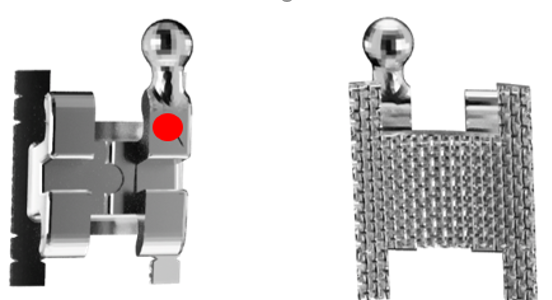
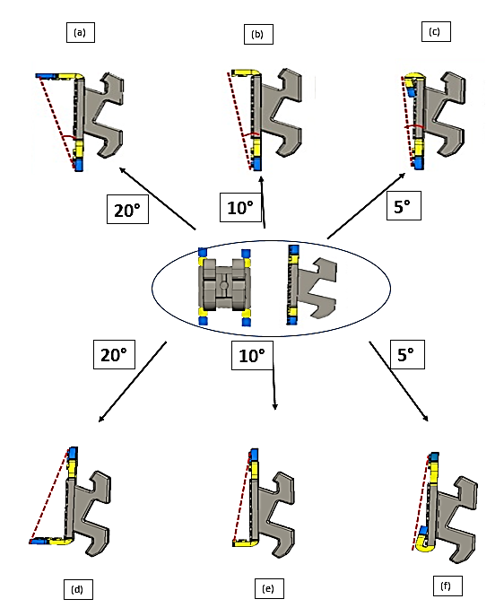
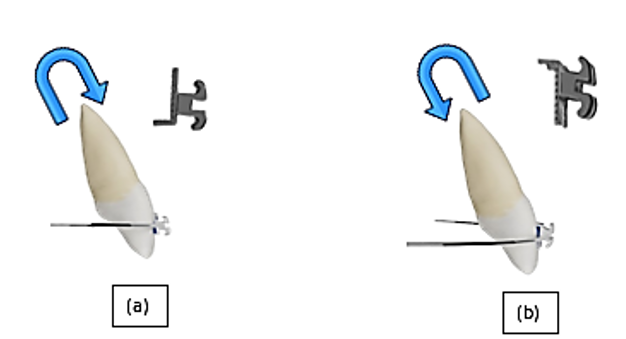
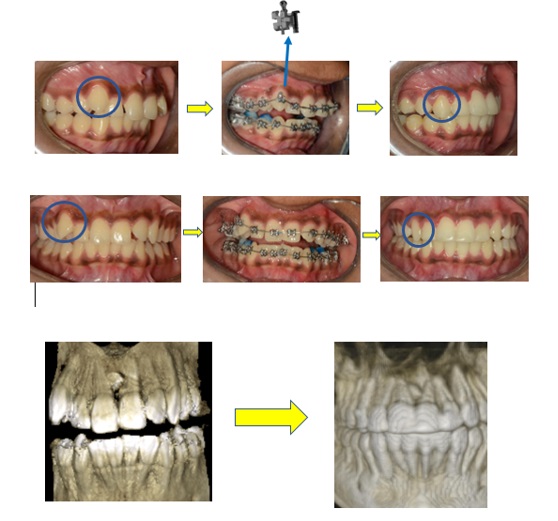
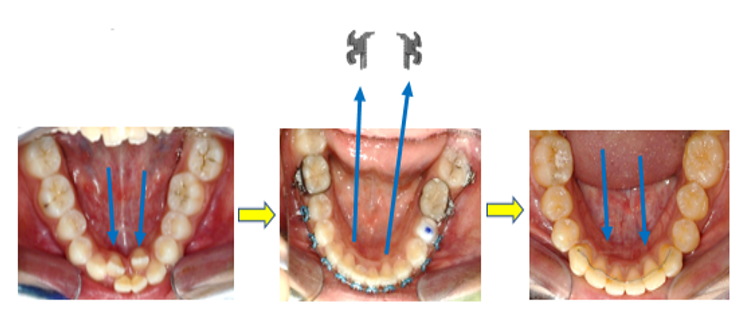

Advantages of this system
The BaTR bracket system is very easy to use and has no learning curve. One gets six different as well as precise torque options (buccal or palatal torque each, in three magnitudes). The inbuilt torque of the brackets being that of the MBT system, this system can be mixed and matched with other normal MBT brackets kits as well, and used only on the teeth requiring extra torque. The legs of the bracket being extentions of the meshwork provide an increased surface area compared to conventional brackets which aid in better bonding. The occluso-gingival legs serve as a guide for proper axial positioning of the bracket. No extra inventory or special instruments are needed.
Case Reports
Case 1
This patient presented with a high and buccally positioned upper right canine with the root contour clearly visible clinically. During treatment, when the canines are brought into the arch, the crown is aligned but the roots remain positioned buccally. To position the canines centered within the bone, additional palatal root torque needs to be incorporated. In this case, instead of using conventional mechanics like bending torque in the wire or using a torqueing auxiliary, we bonded a canine bracket of this BaTR bracket system with the gingival legs bent. This changed the orientation of the slot and delivered a root palatal torque when a rectangular stainless steel wire was inserted into the slot. A 21x25 stainless steel wire was kept ligated for 3 months. At the end of the treatment, we can see that the root torqued palatally and the root contour is not visible clinically.([Figure 4])
Case 2
The patient presented with crowding in the lower arch. The lower lateral incisors were lingually positioned with respect to the rest of the arch. Conventional treatment mechanics requires extra root labial torque to be given to the incisors for correct root positioning. This can be done by either bending single tooth torque in the wire or using torqueing auxiliaries. Instead of using these mechanics, we bent the occlusal legs of the lower lateral incisor brackets of the BaTR system. This additional torque in base changes the orientation of the slot and a root labial torque is delivered when a rectangular stainless steel wire is inserted into the bracket slot. A 21x25 stainless steel wire was kept ligated for 4 months and roots appear to be appropriately positioned within the bone at the end of the treatment ([Figure 5]).
Case 3
The patient presented with crowding in the upper and lower arches. On clinical examination, in the upper arch the canines were buccally positioned and the lateral incisors were palatally positioned. The BaTR brackets were used to get the additional torque in the canine and lateral incisor. The gingival legs of the canine BaTR brackets were bent and the occlusal legs of the BaTR lateral incisor brackets were bent. This created a torque in base itself hence negating the use of torquing auxilliaries or bending torque in the wire. Palatal root torque in the canines and a labial root torque in the lateral incisors was created just by activating the legs of the bracket. A rectangular stainless steel wire was kept ligated for 4 months to achieve the desired result ([Figure 6]).
Conclusion
This innovative BaTR Bracket design gives us six different torque options, all within a single bracket. It is simple, precise and easy to use.
Source of Funding
None.
Conflict of Interest
None.
References
- Germane N, Bentley B, Isaacson R. Three biologic variables modifying faciolingual tooth angulation by straight-wire appliances. Am J Orthod Dentofac Orthop. 1989;96(4):312-21. [Google Scholar]
- Thurow RC. . Edgewise Orthodontics.. 1982. [Google Scholar]
- Begg P, Kesling P. . Begg Orthodontic Theory and Technique. 2008. [Google Scholar]
- Andrews L. . The Straight-Wire Appliance: Syllabus of Philosophy and Techniques, Rev. 1975. [Google Scholar]
- Roth R. The straight-wire appliance 17 years later. J Clin Orthod. 1987;21(9):632-74. [Google Scholar]
- Alexander R. The Vari-Simplex Discipline Part 1 Concept and Appliance Design. J Clin Orthod. 1983;17(6):380-92. [Google Scholar]
- Mclaughlin R, Bennett J, Trevisi H. . Systemized Orthodontic Treatment Mechanics. 2001. [Google Scholar]
- Banker A. Measuring Digital Torque with a Smartphone. J Clin Orthod. 2019;53(9):537-8. [Google Scholar]
How to Cite This Article
Vancouver
Banker AM, Daruwala YN, Shah SS. Use of a new bracket design for variable torque [Internet]. J Contemp Orthod. 2025 [cited 2025 Nov 05];9(1):140-143. Available from: https://doi.org/10.18231/j.jco.2025.020
APA
Banker, A. M., Daruwala, Y. N., Shah, S. S. (2025). Use of a new bracket design for variable torque. J Contemp Orthod, 9(1), 140-143. https://doi.org/10.18231/j.jco.2025.020
MLA
Banker, Alka Manish, Daruwala, Yazad Nozar, Shah, Siddhi Sanjaykumar. "Use of a new bracket design for variable torque." J Contemp Orthod, vol. 9, no. 1, 2025, pp. 140-143. https://doi.org/10.18231/j.jco.2025.020
Chicago
Banker, A. M., Daruwala, Y. N., Shah, S. S.. "Use of a new bracket design for variable torque." J Contemp Orthod 9, no. 1 (2025): 140-143. https://doi.org/10.18231/j.jco.2025.020
